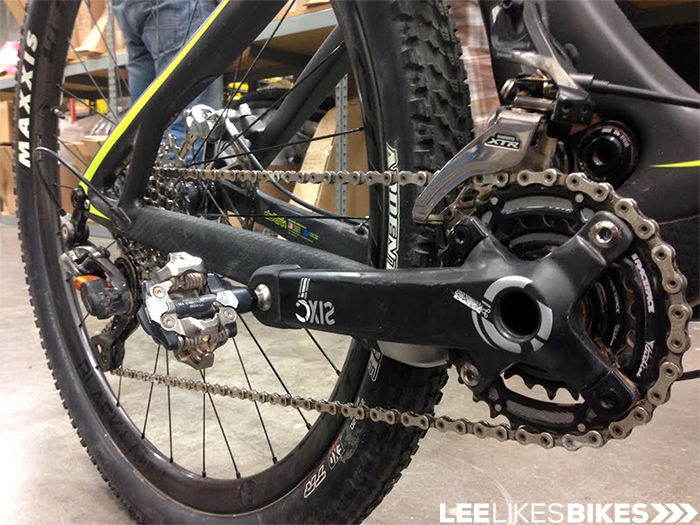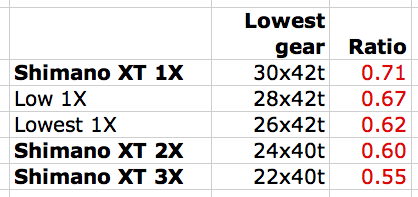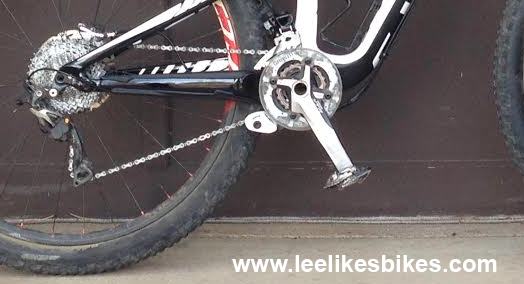Gearing: how looowww can you go?

Lee, I was just catching up on my email and noticed your newsletter article on the 1×11 drivetrain. I ride a 1×11 with a 30t chainring. I feel like I am working my ass off compared to my buddies with their 2×10 setups. What do you suggest? I ride a Santa Cruz Tallboy carbon, I am 60 years old, currently I am in early-season shape but a strong upper-intermediate rider in-season. Your article seems to suggest that a smaller chainring or a switch to a 2×10 might help.
Help!
“Mr. Fatigued” Marc
Marc,
This has been an interesting topic on leelikesbikes.com and Facebook:
Are you strong enough for a 1×11 drivetrain?
To sum it up so far:
1x drivetrains are light and simple and fashionable. If you have the right gearing for your terrain and body — or the right body for your gearing and terrain — they’re a great solution.
When I rode the Pivot Mach4C in Arizona recently, the XTR 1×11 worked perfectly. Here in Colorado, my main trail bikes have XTR or XT 2x10s.
The “classic” 1x solutions allowed a smallest chainring of 28t. This, with a 42t cog, yields a higher low-low gear than a standard 2x setup. For many riders in many places, this is fine.
But it’s not for everyone.
I’m out of touch with the compatibility details, but some of the newest 1x cranksets will fit a 26t ring. A 1x with 26x42t gear gives about the same low as a 2x with a 22x36t. This will work for more people.
But — still! — it’s not for everyone.
Some riders can benefit from even lower gears. Physique, fitness, terrain, fatigue, long warmups, easy training phases, personal preference … for whatever reason, some of us want to turn a smaller gear.
When I visited Pivot, I checked out Chris Cocalis’ personal Mach4C. Chris is a smart, skilled, experienced and fit rider. He rides very steep, technical terrain near the Pivot office (South Mountain!). Do you know what drivetrain he runs? A 2x with a wide-ratio cassette:

I believe Chris runs a 42 in the back, and it looks like a 24 in the front. This gives a low, low, low gear. You might not use it on every ride, but it’s there when you need it. With a clutch derailleur you’re not dropping chains. The only cost is an extra lever and some weight. Again: Cocalis is no schmuck; he’s one of the smartest people in mountain biking!
And now … the new Shimano XT
The new Shimano XT group, which is currently blowing up Pinkbike, comes with 1x, 2x and even 3x options.
There are lots of aftermarket upgrades and hacks out there. There are stock, dialed setups. I am too much of a stress case to gamble with the drivetrains on my work bikes.
XT 1X
30, 32 or 34t ring
11-42 cassette
Lowest gear: 30/42 (0.71)
XT 2X
24-34, 26-36 or 28-38t rings
11-40 cassette
Lowest gear: 24/42 (0.57)
XT 3X
22-32-40t rings
11-40 cassette
Lowest gear: 22/42 (0.52 – the lowest gear out there)

From this chart, you can see the XT 1X setup has a taller low gear than the lowest SRAM 1X. The XT 2X and 3X options give you a lower low gear (and higher high gears).
I’d most likely run the XT 2×11, which gives a pretty low climbing gear and all the top end I’ll ever need.
BTW: On my S-Works Enduro 29 I run an old XT 3X crankset with the two small rings and a Gamut bashguard:

Marc, we have lots of options. At the least, switch your 30t ring to a 28. If your crankset will take it, try a 26. Next step is a 2x drivetrain with a wide-ratio cassette (either stock XT or one of the aftermarket options). I believe 2X can help a lot of riders with minimal drawbacks.
Ride whatever works for you. Have fun out there!
Lee
Know more. Have more fun!
Join the leelikesbikes mailing list:

Leave a Reply
Want to join the discussion?Feel free to contribute!